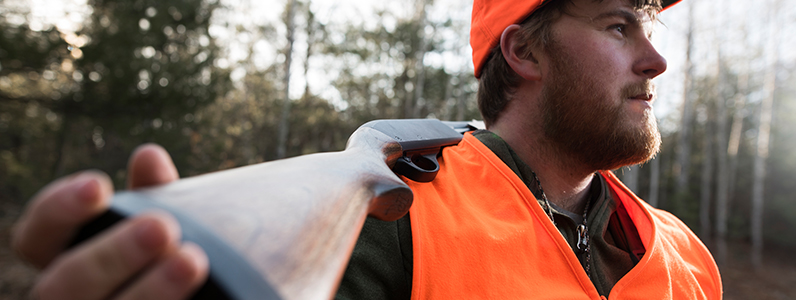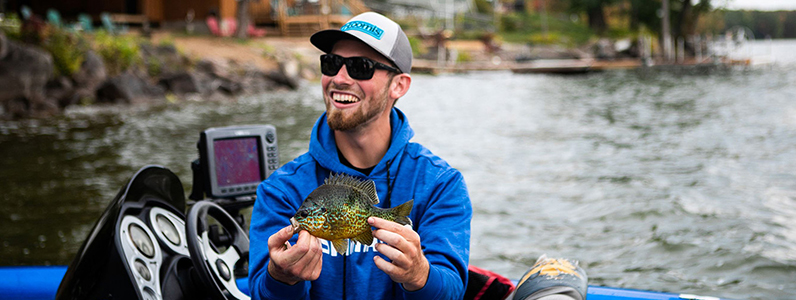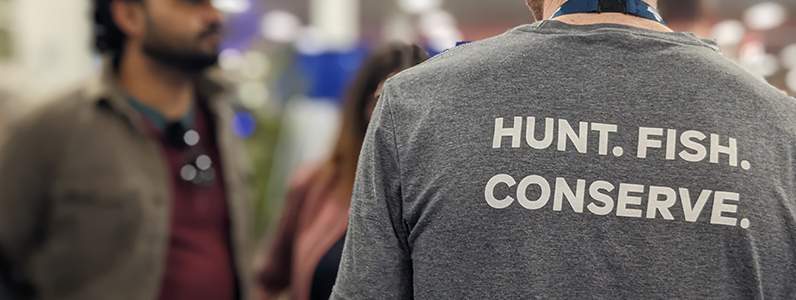EXPLORE OUTDOOR COOKING TECHNIQUES
Prepping camp food
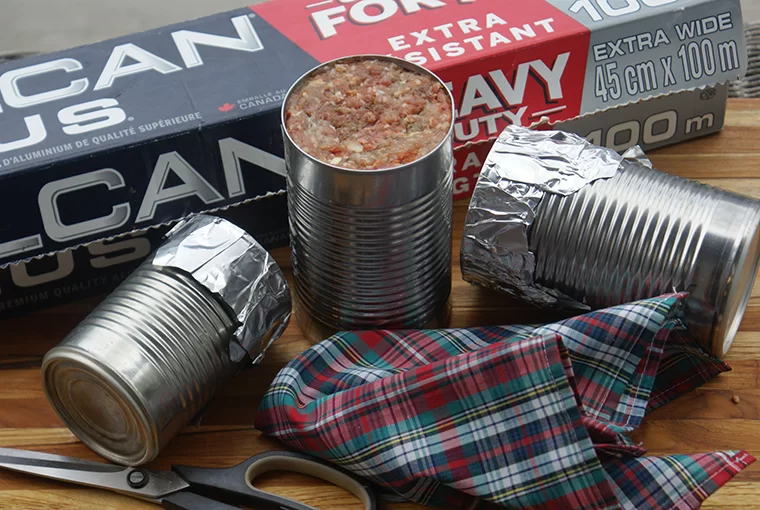
After working up an appetite paddling and portaging cold-water lakes chasing the trophy sprig trout I’ve been dreaming about all winter, I like to have a backup plan for a quick, easy, camp food in case I return with an empty creel. Here are some of my favourites.
Handy tin-can hamburgers
Everybody loves a big, juicy venison or beef patty topped with crispy bacon on a hamburger bun with all the trimmings. But making patties in camp is messy, time-consuming, and requires multiple ingredients. Here’s a better way to do it.
At home:
Prepare the patty mixture by combining ground meat (rule of thumb is four-and-a-half ounces of meat per quarter-pound patty) with minced onion, desired seasonings, egg and cracker or breadcrumbs for binding. Mix these in a bowl, then pack it into a greased food can, cover the open end with aluminum foil or plastic wrap and store in the fridge (or freeze).
Cooking:
Open the bottom of the can with a can opener and use the detached lid to push the meat up through the other end, slicing patties at desired thicknesses. I find a 540-ml can yields four to six patties that fit perfectly on hamburger buns. As for the spent can, burn off the wildlife-attracting odour, squash it flat, and put it in the pack-out garbage bag.
My gang likes bacon on their burgers, so I fry it first and use the drippings for frying the patties.
Go with iron:
A cast iron skillet is heavier to pack than a stainless or aluminum pan, but it’s worth its weight because it holds and distributes heat evenly, an important factor when cooking over the uncontrollable heat of a campfire. It’s also easier to clean as it does not call for dish soap or a scouring pad. Just fill the pan with water, bring to a boil, empty out the residue, rinse with clean water and dry the pan upside-down over the grate.
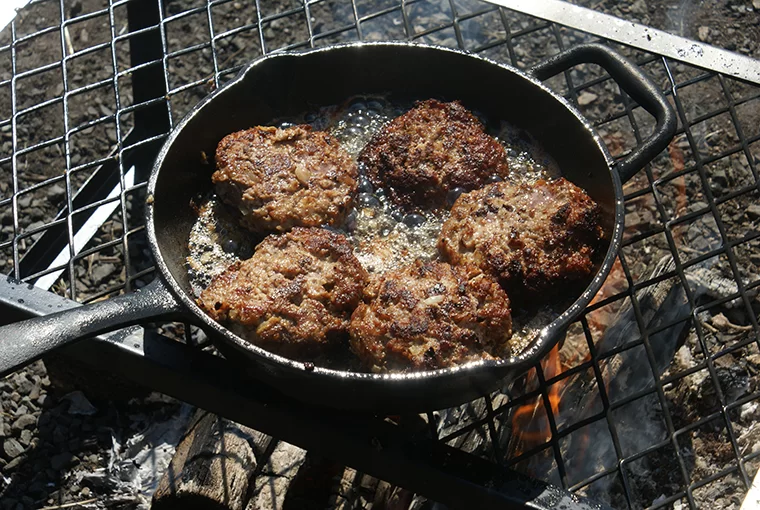
Variation: Easy breakfast sausage “McMuffins”
As with the burgers, load loose, uncased seasoned sausage mixture into an empty food can.
For these, I use a 425-gram can which yields six smaller patties — a perfect fit for breakfast muffins. Open the can as above, slice, fry, and serve the patties on toasted English muffins topped with cheese slices.
Mess-less meatballs & pasta
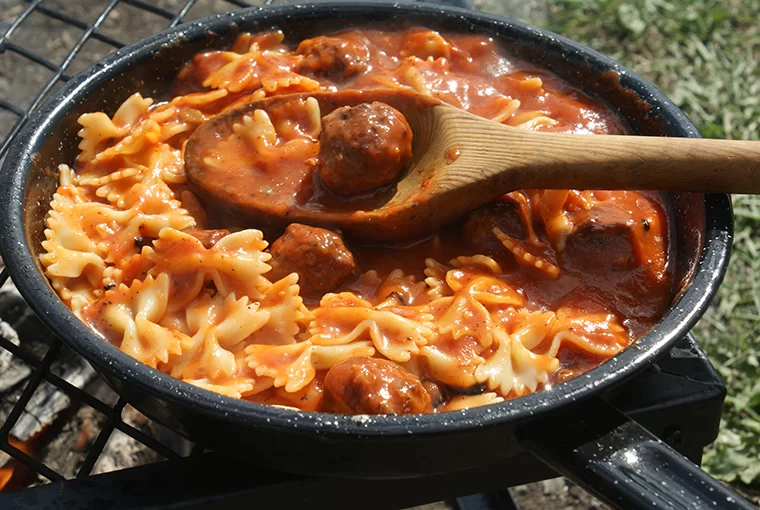
At home:
Meatballs are always a big hit, but like burgers, making them from scratch is messy. So make up a batch at home and place them into empty egg cartons of suitable size for toting. I find a half dozen makes one hefty or two regular-sized servings, whereas a 12 or 18-pack feeds a larger party of paddlers.
Store in the fridge or freeze until ready to load into the icebox. The carton prevents the meatballs from sticking together and getting squashed in transit. It’s also disposable.
Pre-cook the needed amount of pasta — farfalle, shells, and penne stand up well. I count on about one cup of dry pasta per serving. When cooked (al dente, don’t overdo), strain it and toss it with olive oil to prevent sticking before cooling and putting it into a zip-lock bag
Cooking:
To assemble this speedy shoreside supper, fry the meatballs in oil, add a can of pasta sauce, fold in the pasta, heat and eat – right out of the pan if traveling solo. Alternatively, you can make a pasta and meat sauce at home, package it in boilable bags and freeze it. Reheat it by dropping it into boiling water.
Zip-lock omelettes
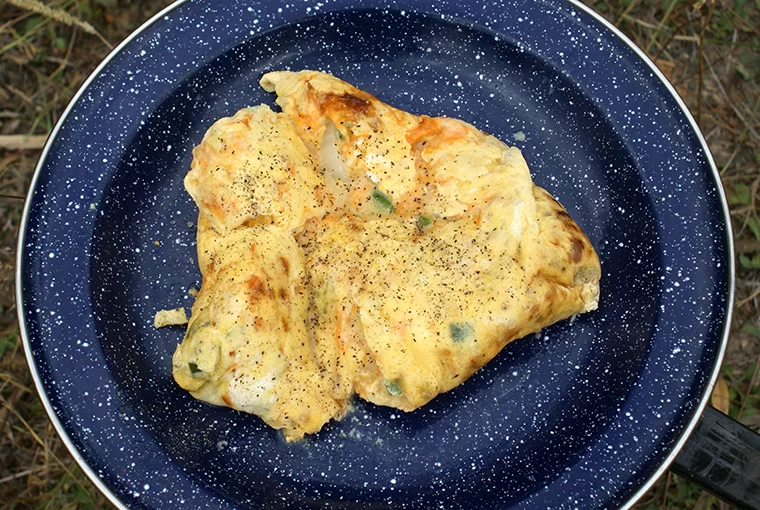
Cold spring mornings call for hot breakfasts and this one is fast and easy.
At home:
You’ll need a medium-size zip-lock or boilable silicone bag per serving and there’s no need for measures.
Simply put your chosen omelette fillings, like grated cheese, diced peppers, onions, ham, and sliced mushrooms, in amounts to suit your taste into the bag and zip up, assembling as many bags as needed.
Next, prepare the eggs by breaking the needed amount into a bowl. I count on three large eggs per serving.
Whisk with one tablespoon of heavy cream per egg, and season with salt and pepper. Pour the egg mixture into an empty milk carton and tote in a cooler with the filled zip-locked bags.
Cooking:
In camp, pour the egg mixture into the zip-lock bags, dividing it up accordingly and massage gently to mix.
Squeeze out excess air and seal. Drop the bag, or a bunch of bags in one shot, into a kettle of boiling water and boil for eight to 10 minutes, or until set. Remove from the water, open the bag, turn out onto a
plate. Or, better yet, roll out onto a large tortilla, wrap up and eat out of hand. No dishes to wash!
Vacuum-sealed camp specials
Chunky stew, meaty chili, and spicy curry are all satisfying meals to warm up with after a brisk day on the water, but these foods call for long, slow cooking so if you want to dish them up fast in camp, prepare them at home in a pressure or slow cooker. Cool and ladle them into vacuum-sealable bags of suitable serving size, stand upright and freeze solid before sealing (which prevents the gravy from being sucked out of the bag). Return them to the freezer until take-off time. In camp, drop the sealed bag into boiling water and simmer until reheated.
Originally published in the April 2023 issue of Ontario OUT of DOORS
